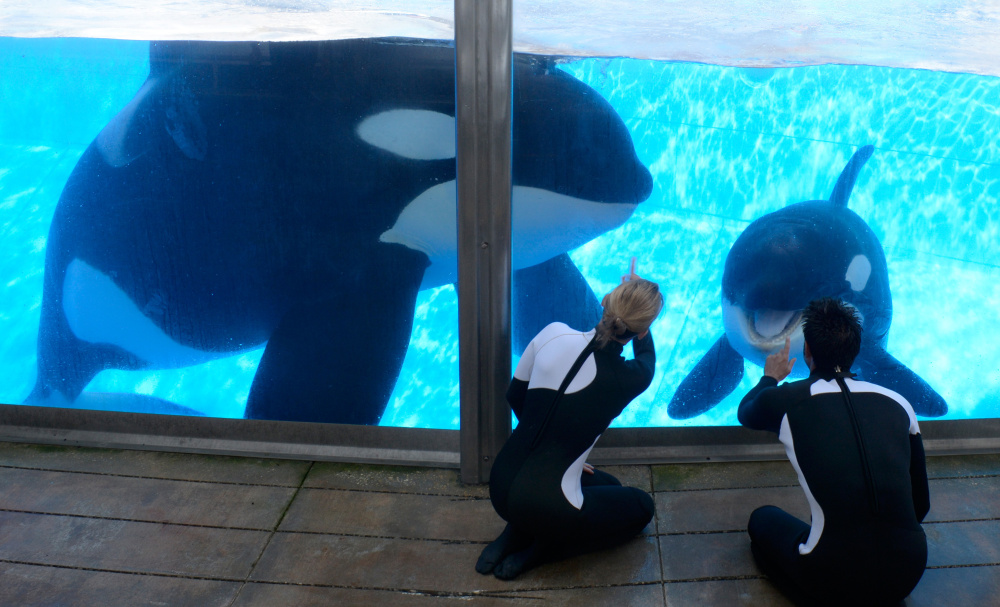Over the last 35 years, America’s most famous living killer whale has shouldered a fraught history, emerging as the symbol of both orcas’ elegance and their capacity for violence. As the focus of the 2013 documentary “Blackfish,” Tilikum – affectionately called “Tili” – has been at once regarded as a victim of captivity and a maker of tragedy.
On Tuesday, SeaWorld Orlando announced that that knotty story may soon be coming to a slow and quiet end.
The marine park that has owned Tilikum for more than two decades said in a statement on its website that he is suffering from an illness that may likely take his life.
“Despite the best care available, like all aging animals, he battles chronic health issues that are taking a greater toll as he ages,” SeaWorld said. “Our teams are treating him with care and medication for what we believe is a bacterial infection in his lungs. However, the suspected bacteria is very resistant to treatment and a cure for his illness has not been found.”
Scott Gearheart, a staff veterinarian, teared up while discussing Tilikum’s prognosis in a SeaWorld video.
“I wish I could say I was tremendously optimistic about Tilikum and his future,” Gearheart said, his voice cracking. “But he has a disease which is chronic and progressive, and at some point might cause his death.”
The veterinarian added: “If he would have shown up with this disease in the wild, there’s no doubt in my mind he’d have been gone a long time ago.”
Male orcas in the wild have an average life span of 50 to 60 years, but the expectancy for killer whales in captivity is much shorter. Tilikum is believed to be about 35 years old; the median survival rate for orcas in U.S. marine parks is just 12 years.
If Tilikum passes away, he will be remembered for a number of things: the three human deaths – among them, the violent passing of SeaWorld darling Dawn Branchaeu – to which he has been linked, the documentary that spurred a movement to have him freed and the complicated questions he has inspired about humans’ relationship to the animals we attempt to control..
In November 1983, Tilikum was found with two female orcas in the icy waters off west Iceland. He was netted as part of an extensive capture network organized by the Don Goldsberry, who created the original Shamu shows with Ted Griffin.
According to Outside Magazine, the killer whales were housed in a concrete holding tank for nearly a year before being transferred to Sealand of the Pacific, a marine park near Victoria, British Columbia..
It was there that the first death occurred.
Eight years after Tilikum and the two female orcas were taken from the wild, a 20-year-old part-time trainer named Keltie Byrne slipped and fell into their tank.
Byrne, a marine biology student and a competitive swimmer, had plenty of experience in water. But none of that matter when faced with several tons of killer whale.
Byrne drowned before anyone could save her.
In 1999, the limp body of 27-year-old Daniel Dukes was found lying across Tilikum’s back. He had recently been released from a county jail, and appeared to have snuck into the park at night. By the time they found Dukes, he had died from drowning.
In February of 2010, Dawn Brancheau was feeding Tilikum when he suddenly grabbed her by the hair and started “thrashing” her around the tank, the Associated Press reported at the time.
To many onlookers, the attack looked deliberate. “We don’t know for sure what motivated Tilikum,” former trainer Jeffrey Ventre told Outside. “But there’s no doubt that he knew exactly what he was doing. He killed her.”
As with the others, Brancheau was dead by the time they got ahold of her body.
Copy the Story LinkSend questions/comments to the editors.



Success. Please wait for the page to reload. If the page does not reload within 5 seconds, please refresh the page.
Enter your email and password to access comments.
Hi, to comment on stories you must . This profile is in addition to your subscription and website login.
Already have a commenting profile? .
Invalid username/password.
Please check your email to confirm and complete your registration.
Only subscribers are eligible to post comments. Please subscribe or login first for digital access. Here’s why.
Use the form below to reset your password. When you've submitted your account email, we will send an email with a reset code.